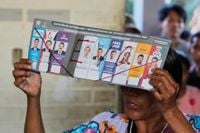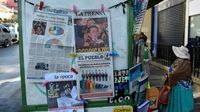Bolivia is on the cusp of a dramatic political shift after its August 17, 2025, presidential election delivered results not seen since the country’s return to democracy in 1982. For the first time in over four decades, Bolivians will return to the polls for a runoff—an event that signals the end of an era dominated by left-wing leadership and opens the door to new political and economic possibilities. The runoff, scheduled for October 19, will pit center-right Senator Rodrigo Paz Pereira against former right-wing interim President Jorge “Tuto” Quiroga, after both candidates failed to secure the absolute majority required for a first-round victory.
Senator Rodrigo Paz, a centrist lawmaker from a storied political family, led the first round with just over 32% of the valid vote, according to the Associated Press. Paz, who previously served as mayor of Tarija and is the son of former President Jaime Paz Zamora, has campaigned under the slogan “Capitalism for all.” This approach marks a decisive break from the statist policies of the long-dominant Movement Toward Socialism (MAS) party. Paz’s campaign promises include lowering tariffs, reducing taxes, and making small loans more accessible for entrepreneurs—measures he argues are vital to rescuing Bolivia from its worst economic crisis in four decades.
“Bolivia is looking for change, looking for renewal,” Paz told the Associated Press after his win. “The vast majority of people have expressed that desire for renewal—merchants, the self-employed, transport workers, the great majority of this country.”
Trailing behind Paz is Jorge “Tuto” Quiroga, who garnered close to 27% of the vote. Quiroga, who briefly served as president in the early 2000s, represents a more traditional right-wing alternative. The runoff was triggered because neither candidate surpassed the 50% threshold, nor did either achieve a 10-point margin while exceeding 40% of the vote—Bolivia’s legal requirements to avoid a second round.
The election also marked a spectacular defeat for the MAS party, which has ruled Bolivia almost uninterrupted since Evo Morales swept to power in 2006 as part of Latin America’s “pink tide.” The official MAS candidate, Eduardo del Castillo, finished a distant sixth with just 3.2% of the vote, while Senate president Andrónico Rodríguez, long considered the party’s best hope, managed only 8%. This collapse was mirrored by the performance of the left more broadly, with Rodríguez’s tally even surpassed by the number of invalid ballots cast.
Indeed, the scale of electoral protest was striking. Over 19% of all ballots were spoiled—either left blank or intentionally mismarked—while an additional 2.5% were left blank, as documented by political scientist Mollie J. Cohen in The Conversation. This rate of invalid voting is nearly four times higher than in elections held between 2006 and 2020, when only about 5% of ballots were spoiled. Blank and spoiled votes are often counted but excluded from the official electoral math, yet they serve as a powerful protest tool in Latin American democracies, allowing voters to express dissatisfaction with the political status quo without withdrawing from the democratic process altogether.
The roots of this widespread discontent run deep. Bolivia is currently grappling with simultaneous economic and political crises. Once buoyed by a commodity boom fueled by exports of lithium and natural gas, the country’s fortunes have reversed as global prices plummeted. National debt has ballooned to 95% of GDP, fuel shortages are widespread, and the annual inflation rate soared to 24% in July 2025, up from just 2% less than two years ago. The shortage of U.S. dollars has made it difficult for Bolivia to pay for essential imports like wheat, further exacerbating the crisis. Presidential candidates across the spectrum have promised austerity measures, including the unpopular move to end fuel subsidies.
The political left, once unified under Morales, is now deeply fractured. Morales, Bolivia’s first Indigenous president, was once celebrated for reducing poverty and expanding the middle class. But his legacy has been tarnished by allegations of democratic backsliding, including stacking courts and ignoring term limits, as well as personal scandal. Morales was barred from running this year due to constitutional term limits and faces an arrest warrant for allegedly impregnating a minor. From his stronghold in Chapare, Morales campaigned for supporters to spoil their ballots as a protest against his exclusion—a move that appears to have resonated, with invalid votes reaching unprecedented levels.
Morales’s campaign for null votes was both a symptom and a cause of the left’s collapse. As Cohen notes, “Morales campaigns for a null vote…widespread ballot spoiling would be a way to send a strong message to those currently in power to allow Morales to run.” Yet, while Morales claimed that a high invalid vote count would demonstrate his enduring influence, the outcome did not meet his ambitions. The spoiled vote did not surpass the totals of the runoff candidates, nor did it reach the 25% threshold he had cited as a symbolic victory.
Despite the high rate of invalid ballots, most Bolivians did choose a candidate, and the majority opted for a shift to the right. “People wanted something new, and, after not finding that in a radical on the right or someone who fully represented socialism, they have obviously opted for Paz,” said Álvaro Chipana, a resident of La Paz, to the Associated Press. This sentiment underscores the electorate’s desire for renewal, but also the depth of their disillusionment with the choices on offer.
The campaign period was not without tension. On election day, Senate president Rodríguez was assaulted by pro-Morales crowds in Chapare as he attempted to vote, highlighting the volatility of the current political climate. Nevertheless, authorities reported that voting was otherwise largely peaceful, with only minor disruptions.
President Luis Arce, a former Morales protégé whose popularity plummeted amid the economic crisis, acknowledged the historic nature of the election. “Now, the ball is in the hands of the Bolivian people,” Arce said, adding, “Democracy has triumphed!”
Looking ahead to the October runoff, Bolivia stands at a crossroads. The electorate’s embrace of protest voting, combined with the collapse of the left and the rise of centrist and right-wing alternatives, suggests that whoever emerges victorious will face the daunting task of restoring trust in democracy and tackling the country’s severe economic woes. Over a million Bolivians used their ballots not to select a leader, but to send a message to the political establishment—a message that cannot be ignored.
As Bolivia prepares for the next round, the country’s leaders will need to bridge deep social, political, and economic divides. The outcome of the runoff will not only determine the next president but will also test the resilience of Bolivian democracy and the willingness of its leaders to respond to the clear call for change.


